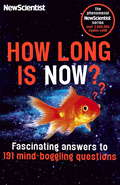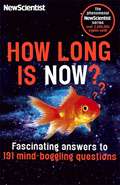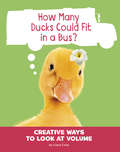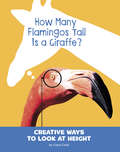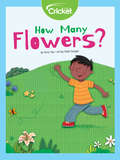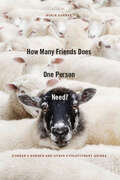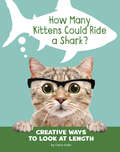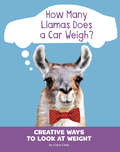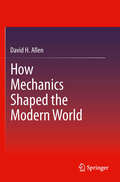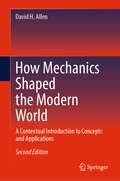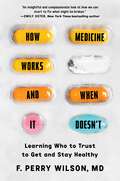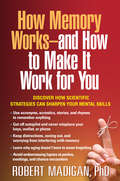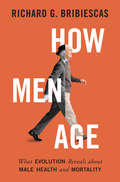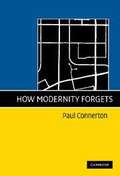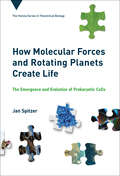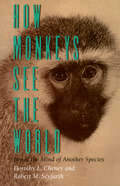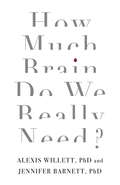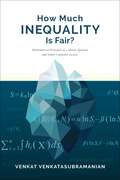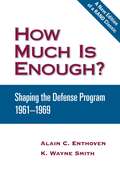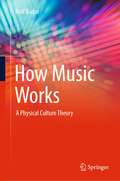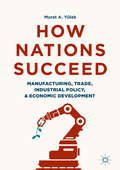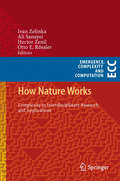- Table View
- List View
How Long is Now?: Fascinating Answers to 191 Mind-Boggling Questions
by New ScientistA Sunday Times bestsellerHow long is 'now'? The short answer is 'somewhere between 2 and 3 seconds'. The long answer involves an incredible journey through neuroscience, our subconscious and the time-bending power of meditation. Living in the present may never feel the same. Ready for some more? Okay. Why isn't Pluto a planet? Why are dogs' noses wet? Why do hens cluck more loudly after laying an egg? What happens when one black hole swallows another? Do our fingerprints change as we get older? How young can you die of old age? And what is at the very edge of the Universe?Life is full of mind-bending questions. And, as books like What If? and Why Don't Penguins' Feet Freeze? have shown, the route to find each answer can take us on the weirdest and most wonderful journeys. How Long is Now? is a fascinating new collection of questions you never thought to ask, along with answers that will change the way you see everything.
How Long is Now?: And 101 Other Questions You Never Thought To Ask
by New ScientistHow long is 'now'? The short answer is 'somewhere between 2 and 3 seconds'. The long answer involves an incredible journey through neuroscience, our subconscious and the time-bending power of meditation. Living in the present may never feel the same. Ready for some more? Okay. Why isn't Pluto a planet? Why are dogs' noses wet? Why do hens cluck more loudly after laying an egg? What happens when one black hole swallows another? Do our fingerprints change as we get older? How young can you die of old age? And what is at the very edge of the Universe? Life is full of mind-bending questions. And, as books like What If? and Why Don't Penguins' Feet Freeze? have shown, the route to find each answer can take us on the weirdest and most wonderful journeys. How Long is Now? is a fascinating new collection of questions you never thought to ask, along with answers that will change the way you see everything.
How Majestic Is Thy Name: Delighting In The Grandeur Of God
by Steve Terrill Steve HallidayCombining the most astounding photography with the most terrific information and the most marvelous scripture, this is one of the finest and most elaborate gift books published by New Leaf Press.
How Many Ducks Could Fit in a Bus?: Creative Ways to Look at Volume (Silly Measurements)
by Clara CellaEight outside-the-box measuring units, from ducks to donuts, introduce pre-readers to the math concept of volume. Wonderous composite photos and a dash of text illustrate the volume of a bus, a bathtub, a teacup, and more in fresh, non-standard ways.
How Many Flamingos Tall Is a Giraffe?: Creative Ways to Look at Height (Silly Measurements)
by Clara CellaFlamingos, jack-o'-lanterns, and six other fun, non-standard measuring units demonstrate the math concept of height. Through the use of whimsical composite photos and a hint of text, pre-readers learn the height of a giraffe, a snowman, a tennis ball, and more.
How Many Flowers
by Amy TaoDo you know how new fruit is made? Learn about the different parts of a fruit plant’s flower—the stigma, pistil, and stamen—and how they use pollen to make seeds in a process called pollination! The seeds grow into new flowers, which turn into fruit after they’re pollinated!
How Many Friends Does One Person Need?: Dunbar's Number And Other Evolutionary Quirks
by Robin DunbarWe are the product of our evolutionary history and this history colours our everyday lives - from why we kiss to how religious we are. In "How Many Friends Does One Person Need?" Robin Dunbar explains how the distant past underpins our current behaviour, through the groundbreaking experiments that have changed the thinking of evolutionary biologists forever. He explains phenomena such as why 'Dunbar's Number' (150) is the maximum number of acquaintances you can have, why all babies are born premature and the science behind lonely hearts columns. Stimulating, provocative and highly enjoyable, this fascinating book is essential for understanding why humans behave as they do - what it is to be human.
How Many Kittens Could Ride a Shark?: Creative Ways to Look at Length (Silly Measurements)
by Clara CellaIntroduce pre-readers to the math concept of length with eight goofy, non-standard measuring units, including kittens, toy airplanes, and gumballs. Delightful composite photos and a sprinkling of text illustrate the length of a shark, a lemur tail, a crayon, and more.
How Many Llamas Does a Car Weigh?: Creative Ways to Look at Weight (Silly Measurements)
by Clara CellaLlamas, hot dogs, and six other silly, non-standard measuring units demonstrate the math concept of weight. Pre-readers learn the weight of a car, a hummingbird, a burger, and more through the use of surprising composite photos and a bit of text.
How Many Planets Circle the Sun?: And Other Questions About Our Solar System (Good Question!)
by M. CarsonWhy is there life on earth? How did Saturn get its rings? Which planet is biggest, which ones hottest—and which has a cloud named Scooter? Take a trip into outer space to learn about the asteroid belt, Martian volcanoes, dwarf planets, and other fascinating facts about our universe.
How Mechanics Shaped the Modern World
by David H. AllenThis unique book presents a nontechnical view of the history of mechanics, from the Big Bang to present day. The impact of mechanics on the evolution of a variety of subjects is vividly illustrated, including astronomy, geology, astrophysics, anthropology, archeology, ancient history, Renaissance art, music, meteorology, modern structural engineering, mathematics, medicine, warfare, and sports. While enormous in scope, the subject matter is covered (with ample photographic support) at a level designed to capture the interest of both the learned and the curious. The book concludes with a creative and thoughtful examination of the current state of mechanics and possibilities for the future of mechanics.
How Mechanics Shaped the Modern World: A Contextual Introduction to Concepts and Applications
by David H. AllenThis updated and augmented second edition covers the history of mechanics in such a way as to explain how this all-important discipline shaped our world. Like the first edition, Dr. Allen presents the material in an engaging, accessible manner, with many historic insights and thorough explanations of attending concepts. The text retains its coverage of classical mechanics, essentially Newtonian mechanics, and adds chapters on three additional topics that go well beyond classical mechanics: relativity, quantum/nanomechanics, and biomechanics.
How Medicine Works and When It Doesn't: Learning Who to Trust to Get and Stay Healthy
by F. Perry WilsonBlending personal anecdotes with hard science, an accomplished physician, researcher, and science communicator gives you the tools to avoid medical misinformation and take control of your health: "A brilliant step toward patients and physicians alike reclaiming a sense of confidence in a system that often feels overwhelming and mismanaged" (Gabby Bernstein, #1 New York Times bestselling author of The Universe Has Your Back). We live in an age of medical miracles. Never in the history of humankind has so much talent and energy been harnessed to cure disease. So why does it feel like it&’s getting harder to live our healthiest lives? Why does it seem like &“experts&” can&’t agree on anything, and why do our interactions with medical professionals feel less personal, less honest, and less impactful than ever? Through stories from his own practice and historical case studies, Dr. F. Perry Wilson, a physician and researcher from the Yale School of Medicine, explains how and why the doctor-patient relationship has eroded in recent years and illuminates how profit-driven companies—from big Pharma to healthcare corporations—have corrupted what should have been medicine&’s golden age. By clarifying the realities of the medical field today, Dr. Wilson gives readers the tools they need to make informed decisions, from evaluating the validity of medical information online to helping caregivers advocate for their loved ones, in the doctor&’s office and with the insurance company. Dr. Wilson wants readers to understand medicine and medical science the way he does: as an imperfect and often frustrating field, but still the best option for getting well. To restore trust between patients, doctors, medicine, and science, we need to be honest, we need to know how to spot misinformation, and we need to avoid letting skepticism ferment into cynicism. For it is only by redefining what &“good medicine&” is—science that is well-researched, rational, safe, effective, and delivered with compassion, empathy, and trust—that the doctor-patient relationship can be truly healed.
How Memory Works--and How to Make It Work for You: G1196
by Robert MadiganDo you wish you could recall the names of people you just met? What if birthdays, important errands, and online passwords rarely slipped your mind? Psychologist Robert Madigan is an expert in the "memory arts"--practical, proven methods for improving the ability to retain and use information. Like taking the stairs instead of the elevator, it's important to exercise memory in simple ways every day. That's where this science-based guide can help. Dr. Madigan explains how memory works and presents innovative mnemonic devices and visualization techniques that will help you sharpen your mental skills; avoid embarrassing lapses; and remember faces, appointments, facts, numbers, lists, and much more. Reclaim your brain--this book shows how.
How Men Age: What Evolution Reveals about Male Health and Mortality
by Richard G. BribiescasWhile the health of aging men has been a focus of biomedical research for years, evolutionary biology has not been part of the conversation--until now. How Men Age is the first book to explore how natural selection has shaped male aging, how evolutionary theory can inform our understanding of male health and well-being, and how older men may have contributed to the evolution of some of the very traits that make us human.In this informative and entertaining book, renowned biological anthropologist Richard Bribiescas looks at all aspects of male aging through an evolutionary lens. He describes how the challenges males faced in their evolutionary past influenced how they age today, and shows how this unique evolutionary history helps explain common aspects of male aging such as prostate disease, loss of muscle mass, changes in testosterone levels, increases in fat, erectile dysfunction, baldness, and shorter life spans than women. Bribiescas reveals how many of the physical and behavioral changes that we negatively associate with male aging may have actually facilitated the emergence of positive traits that have helped make humans so successful as a species, including parenting, long life spans, and high fertility.Popular science at its most compelling, How Men Age provides new perspectives on the aging process in men and how we became human, and also explores future challenges for human evolution--and the important role older men might play in them.
How Modernity Forgets
by Paul ConnertonWhy are we sometimes unable to remember events, places and objects? This concise overview explores the concept of 'forgetting', and how modern society affects our ability to remember things. It takes ideas from Francis Yates classic work, 'The Art of Memory', which viewed memory as being dependent on stability, and argues that today's world is full of change, making 'forgetting' characteristic of contemporary society. We live our lives at great speed; cities have become so enormous that they are unmemorable; consumerism has become disconnected from the labour process; urban architecture has a short life-span; and social relationships are less clearly defined- all of which has eroded the foundations on which we build and share our memories. Providing a profound insight into the effects of modern society, this book is a must-read for anthropologists, sociologists, psychologists and philosophers, as well as anyone interested in social theory and the contemporary western world.
How Molecular Forces and Rotating Planets Create Life: The Emergence and Evolution of Prokaryotic Cells (Vienna Series in Theoretical Biology)
by Jan SpitzerA reconceptualization of origins research that exploits a modern understanding of non-covalent molecular forces that stabilize living prokaryotic cells.Scientific research into the origins of life remains exploratory and speculative. Science has no definitive answer to the biggest questions--"What is life?" and "How did life begin on earth?" In this book, Jan Spitzer reconceptualizes origins research by exploiting a modern understanding of non-covalent molecular forces and covalent bond formation--a physicochemical approach propounded originally by Linus Pauling and Max Delbrück. Spitzer develops the Pauling-Delbrück premise as a physicochemical jigsaw puzzle that identifies key stages in life's emergence, from the formation of first oceans, tidal sediments, and proto-biofilms to progenotes, proto-cells and the first cellular organisms.
How Monkeys See the World: Inside the Mind of Another Species
by Robert M. Seyfarth Dorothy L. CheneyCheney and Seyfarth enter the minds of vervet monkeys and other primates to explore the nature of primate intelligence and the evolution of cognition. "This reviewer had to be restrained from stopping people in the street to urge them to read it: They would learn something of the way science is done, something about how monkeys see their world, and something about themselves, the mental models they inhabit."—Roger Lewin, Washington Post Book World "A fascinating intellectual odyssey and a superb summary of where science stands."—Geoffrey Cowley, Newsweek "A once-in-the-history-of-science enterprise."—Duane M. Rumbaugh, Quarterly Review of Biology
How Much Brain Do We Really Need?
by Dr Jennifer Barnett Dr Alexis WillettYour brain is shrinking. Does it matter?How Much Brain Do We Really Need? challenges us to think differently about the brain. Rather than just concentrating on the many wonderful things it can do, this entertaining insight into the complexities and contradictions of the human brain asks whether in fact we can live satisfactorily without some of it.The bad news is that our brains start to shrink from our mid-thirties. But the good news is that we still seem to generally muddle along and our brain is able to adapt in extraordinary ways when things going wrong.Alexis Willett and Jennifer Barnett shed light on what the human brain can do - in both optimal and suboptimal conditions - and consider what it can manage without. Through fascinating facts and figures, case studies and hypothetical scenarios, expert interviews and scientific principles, they take us on a journey from the ancient mists of time to the far reaches of the future, via different species and lands.Is brain training the key to healthy ageing? Do women really experience 'baby brain'? Is our brain at its evolutionary peak or do we have an even more brilliant future to look forward to? We discover the answers to these questions and more.
How Much Brain Do We Really Need?
by Dr Jennifer Barnett Dr Alexis WillettYour brain is shrinking. Does it matter?Rethinking the Brain challenges us to think differently. Rather than just concentrating on the many wonderful things the brain can do, this entertaining insight into its complexities and contradictions asks whether in fact we can live satisfactorily without some of it.The bad news is that our brains start to shrink from our mid-thirties. But the good news is that we still seem to generally muddle along and our brain is able to adapt in extraordinary ways when things going wrong.Alexis Willett and Jennifer Barnett shed light on what the human brain can do - in both optimal and suboptimal conditions - and consider what it can manage without. Through fascinating facts and figures, case studies and hypothetical scenarios, expert interviews and scientific principles, they take us on a journey from the ancient mists of time to the far reaches of the future, via different species and lands.Is brain training the key to healthy ageing? Do women really experience 'baby brain'? Is our brain at its evolutionary peak or do we have an even more brilliant future to look forward to? We discover the answers to these questions and more.
How Much Inequality Is Fair?: Mathematical Principles of a Moral, Optimal, and Stable Capitalist Society
by Venkat VenkatasubramanianMany in the United States feel that the nation’s current level of economic inequality is unfair and that capitalism is not working for 90% of the population. Yet some inequality is inevitable. The question is: What level of inequality is fair? Mainstream economics has offered little guidance on fairness and the ideal distribution of income. Political philosophy, meanwhile, has much to say about fairness yet relies on qualitative theories that cannot be verified by empirical data. To address inequality, we need to know what the goal is—and for this, we need a quantitative, testable theory of fairness for free-market capitalism.How Much Inequality Is Fair? synthesizes concepts from economics, political philosophy, game theory, information theory, statistical mechanics, and systems engineering into a mathematical framework for a fair free-market society. The key to this framework is the insight that maximizing fairness means maximizing entropy, which makes it possible to determine the fairest possible level of pay inequality. The framework therefore provides a moral justification for capitalism in mathematical terms. Venkat Venkatasubramanian also compares his theory’s predictions to actual inequality data from various countries—showing, for instance, that Scandinavia has near-ideal fairness, while the United States is markedly unfair—and discusses the theory’s implications for tax policy, social programs, and executive compensation.
How Much Is Enough?
by K. Wayne Smith Alain C. EnthovenOriginally published in 1971, and now published with a new foreword, this is a book of enduring value and lasting relevance. The authors detail the application, history, and controversies surrounding the Planning, Programming, and Budgeting System (PPBS), used to evaluate military needs and to choose among alternatives for meeting those needs.
How Music Works: A Physical Culture Theory
by Rolf BaderHow do we understand culture and shape its future? How do we cross the bridge between culture as ideas and feelings and physical, cultural objects, all this within the endless variety and complexity of modern and traditional societies? This book proposes a Physical Culture Theory, taking culture as a self-organizing impulse pattern of electric forces. Bridging the gap to consciousness, the Physical Culture Theory proposes that consciousness content, what we think, hear, feel, or see is also just this: spatio-temporal electric fields. Music is a perfect candidate to elaborate on such a Physical Culture Theory. Music is all three, musical instrument acoustics, music psychology, and music ethnology. They emerge into living musical systems like all life is self-organization. Therefore the Physical Culture Theory knows no split between nature and nurture, hard and soft sciences, brains and musical instruments. It formulates mathematically complex systems as Physical Models rather than Artificial Intelligence. It includes ethical rules for maintaining life and finds culture and arts to be Human Rights. Enlarging these ideas and mathematical methods into all fields of culture, ecology, economy, or the like will be the task for the next decades to come.
How Nations Succeed: Manufacturing, Trade, Industrial Policy, and Economic Development
by Murat A. YülekThis book assesses developmental experience in different countries as well as British expansion following the industrial revolution from a developmental perspective. It explains why some nations are rich and others are poor, and discusses how manufacturing made economies flourish and spur economic development. It explains how today’s governments can design and implement industrial policy, and how they can determine economically strategic sectors to break out of Low and Middle Income Traps.Closely linked to global trade and (im)balances, industrialization was never an accident. Industrialization explains how some countries experience export-led growth and others import-led slowdowns. Many confuse industrialization with the construction of factory buildings rather than a capacity and skill building process through certain stages. Industrial policy helps countries advance through those stages. Explaining technical concepts in understandable terms, the book discusses the capacity and limits of the developmental state in industrialization and in general in economic development, demonstrating how picking-the-winner type focused industrial policy has worked in different countries. It also discusses how industrial policy and science, technology and innovation policies should be sequenced for best results.
How Nature Works: Complexity in Interdisciplinary Research and Applications
by Ali Sanayei Otto E. Rössler Hector Zenil Ivan ZelinkaThis book is based on the outcome of the "2012 Interdisciplinary Symposium on Complex Systems" held at the island of Kos. The book consists of 12 selected papers of the symposium starting with a comprehensive overview and classification of complexity problems, continuing by chapters about complexity, its observation, modeling and its applications to solving various problems including real-life applications. More exactly, readers will have an encounter with the structural complexity of vortex flows, the use of chaotic dynamics within evolutionary algorithms, complexity in synthetic biology, types of complexity hidden inside evolutionary dynamics and possible controlling methods, complexity of rugged landscapes, and more. All selected papers represent innovative ideas, philosophical overviews and state-of-the-art discussions on aspects of complexity. The book will be useful as instructional material for senior undergraduate and entry-level graduate students in computer science, physics, applied mathematics and engineering-type work in the area of complexity. The book will also be valuable as a resource of knowledge for practitioners who want to apply complexity to solve real-life problems in their own challenging applications. The authors and editors hope that readers will be inspired to do their own experiments and simulations, based on information reported in this book, thereby moving beyond the scope of the book.
